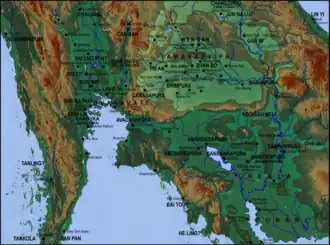Zhū Jiāng Kingdom
Zhū Jiāng Kingdom | |||||||||
|---|---|---|---|---|---|---|---|---|---|
| 7th–8th centuries | |||||||||
 Proposed locations of ancient kingdoms in Menam and Mekong Valleys in the 7th century based on the details provided in the Chinese leishu, Cefu Yuangui, and others. | |||||||||
| Capital | Champasri | ||||||||
| Religion | Buddhism | ||||||||
| Government | Kingdom | ||||||||
| Historical era | Post-classical era | ||||||||
• Established | 7th century | ||||||||
• First mentioned in a Chinese source | 7th century | ||||||||
• Dvaravati sphere | 7th–9th-c. | ||||||||
• Angkorian sphere | 10th–12th-c. | ||||||||
• Destroyed by Lan Xang | 14th century | ||||||||
| |||||||||
| Today part of | Thailand | ||||||||
Zhū Jiāng Kingdom (Chinese: 朱江国; lit. 'country of red river') was an ancient kingdom in present-day central Thailand mentioned in the Chinese leishu, Cefu Yuangui,[1] and the Book of Sui.[2] It was located to the west of Zhenla.[1]: 16 [2]
After Zhenla annexed Funan in 627, Zhū Jiāng, which has been identified as one of Dvaravati-influenced polities,[3] and another kingdom, Cān Bàn, allied via royal intermarriage with Zhenla. They then fought several wars against Tou Yuan to the northwest.[4] Tou Yuan later became a vassal of Dvaravati in 647.[5]: 269 [6]: 15–16 In addition, Zhenla also waged wars against Línyì to the northeast at the time mentioned.[4]
According to the Laotian Phra That Phanom Chronicle, its proposed chief city, Champasri, and several satellite settlements, together with the neighboring kingdom of Kuruntha at Saket Nakhon (present-day Roi Et), were destroyed by King Fa Ngum of Luang Phrabang after he successfully reunited the Laotian Kingdoms in the 14th century.[7] Local sage claims that King of Champasri had a close dynastic relation with Mahendravarman, King of Chenla.[7]
Location
In the Book of Sui Volume 82, says Zhū Jiāng was southwest of Linyi, west of Zhenla, which itself bordered the Kingdom of Chequ to the south.[2]
...真腊国,在林邑西南,本扶南国之属国也,去日南郡舟行六十日而至,南接车渠国,西有朱江国。... ...The Kingdom of Zhenla was located in the southwest of Linyi and was originally a vassal state of the Kingdom of Funan. It was 60 days’ boat ride away from Rinan County. It bordered the Kingdom of Chequ to the south and the Kingdom of Zhujiang to the west...
— Wang Qinruo and others of the Song Dynasty, Cefu Yuangui, volume 957
Chinese historian Chen Jiarong (陳佳榮) proposes that Zhū Jiāng means a red river, referring to the Chao Phraya River in Thailand, and Zhujiang is another name for Duò Luó Bō Dǐ (墮羅鉢底國; Dvaravati) in its lower basin.[3] In this case, Zhū Jiāng royal intermarried with Zhenla, and annexed Tou Yuan to the northwest, potentially leading the Old Book of Tang Volume 197 to assert that the Pyu Kingdoms bordered Zhenla to the east.[3]
Some say Zhū Jiāng is a corrupted name of Zhū Bō (朱波) in the New Book of Tang, which is identified with Pyu Kingdoms in present-day Myanmar, or it might be some country that controlled the Irrawaddy River Basin, which was called by the Chinese the "Black Water Silt River" (黑水淤泥河). Its water is turbid and slightly red, so it is named the "Zhu River" (朱江). Some believe it was in the Mekong Basin,[3] or the Mun Valley.[8]: 218 [9]: 45–7
References
- ^ a b "钦定四库全书: 册府元龟卷九百五十七宋王钦若等撰". Ministry of Foreign Affairs of the People's Republic of China (in Chinese). Retrieved 14 May 2025.
- ^ a b c Book of Sui, Volume 82 (in Chinese) Retrieved 17 May 2025.
- ^ a b c d "朱江". www.world10k.com (in Chinese). Archived from the original on 17 May 2025. Retrieved 17 May 2025.
{{cite web}}: CS1 maint: bot: original URL status unknown (link) - ^ a b "中国哲学书电子化计划". ctext.org (in Chinese). Archived from the original on 16 May 2025. Retrieved 16 May 2025.
{{cite web}}: CS1 maint: bot: original URL status unknown (link) - ^ Lawrence Palmer Briggs (1950). "The Khmer Empire and the Malay Peninsula". The Far Eastern Quarterly. 9 (3). Duke University Press: 256–305. doi:10.2307/2049556. JSTOR 2049556. Archived from the original on 17 May 2025. Retrieved 18 May 2025.
{{cite journal}}: CS1 maint: bot: original URL status unknown (link) - ^ Geoffrey Goble (2014). "Maritime Southeast Asia: The View from Tang-Song China" (PDF). ISEAS – Yusof Ishak Institute. p. 1–19. ISSN 2529-7287. Archived from the original (PDF) on 2022-06-19.
- ^ a b "ระบำจัมปาศรี" [Champasri Dance]. www.isan.clubs.chula.ac.th (in Thai). 2018. Retrieved 9 August 2025.
- ^ David Welch (1998). "Archaeology of Northeast Thailand in Relation to the Pre-Khmer and Khmer Historical Records". International Journal of Historical Archaeology. 2 (3).
- ^ Lawrence Palmer Briggs (1951). "The Ancient Khmer Empire" (PDF). Transactions of the American Philosophical Society. 4 (1): 1–295. doi:10.2307/1005620. JSTOR 1005620.